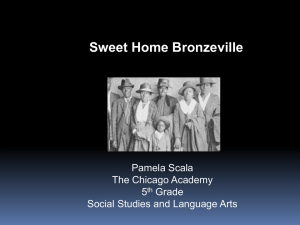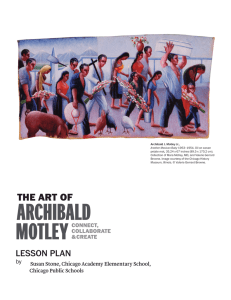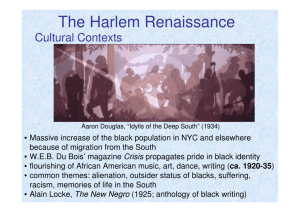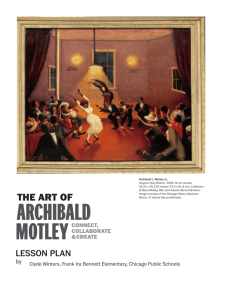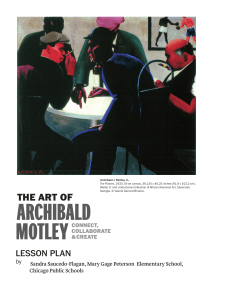Archibald Motley Jr.
advertisement
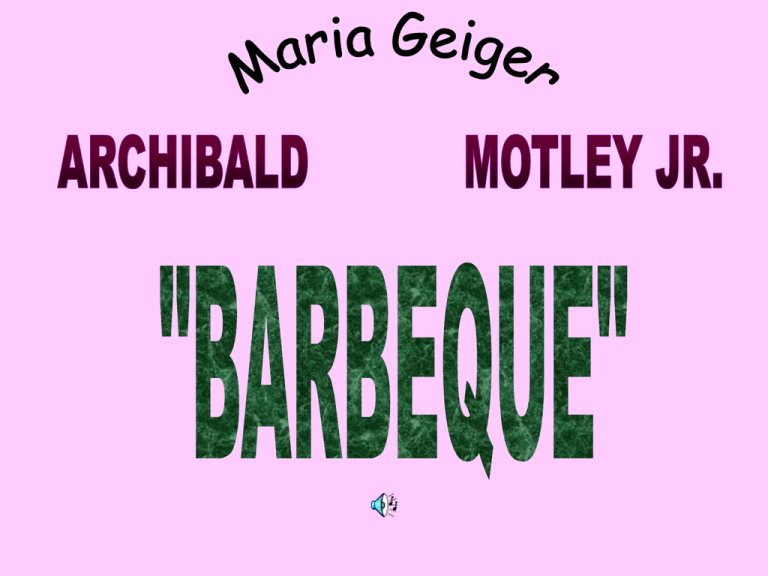
“BARBEQUE” by Archibald Motley Jr. INTRODUCTION TO THE LIFE OF ARCHIBALD MOTLEY JR Archibald Motley Jr. was born on October 7, 1871 in New Orleans, La. At the age of two, he moved with his family to Chicago. Raised by an affluent family, Archibald was always interested in art. After graduating from high school, he continued his art training at the Chicago Institute of Art. Due to his race, he had a hard time finding work. In 1924, his first painting, of his grandmother, (a former slave) entitled Mending Socks gained public praise. In 1928, Motley had his first solo exhibit in New York City, where nearly every painting displayed was sold. Motley was one of the first African American Artists to have a gallery show. Archibald Motley won a Guggenheim Fellowship in 1928 which allowed him to travel to Paris. PARIS The time Motley spent in Paris influenced him to paint black nightlife when he returned to Chicago. Although he never lived in Harlem, his depiction of contemporary African American social life identified him with the Harlem Renaissance. Archibald Motley Jr. 1943 “Nightlife” Oil on canvas Archibald Motley Jr. specialized in painting African Americans enjoying the nightlife. He used a modern technique to capture his scenes. The people in “Barbeque” do not have distinct features. Motley makes the painting’s main idea black people who were like everyone else, moving on and enjoying life. One does not get a sense of oppression, but then realizes that there are no white people in the painting, either.Without discrimination, these black Americans are free to enjoy life like everyone else in America. “Barbeque” Oil on canvas 1934 The Harlem Renaissance Started in 1919, the Harlem Renaissance was a time when African Americans produced an amazing amount of art, literature and music. The movement was based primarily in Harlem, New York City. It ended during the early to mid nineteen-thirties. This group of African Americans were out to challenge stereotypes, while creating memorable art and literature. “Barbeque” is full of life. This look is achieved by using rhythm and repetition, with the repeating purple-tinged tablecloths and the black suits on the men. This painting has a “full of motion” look to it. “Barbeque”, although not perfectly symmetrically balanced, appears visually balanced by the strategic placement of the color yellow, which balances the black suits. Being that yellow, red and blue paints are primarily used, I would say the color scheme is primary, with a lot of black. In the background of the painting, there is an interesting string of double lights. Motley had an interest in how figures look under artificial light. The light seems to be coming from behind the figures, emphasizing their shape. Motley put his “signature blue” in almost every painting he painted. Motley showed black people as they were; fun-loving, laughing, and unpretentious. Motley explained that “In order to study them (African Americans in Chicago) I made a habit to go to places where they gathered a lot, like churches, movie houses, dance halls, skating rinks, sporting houses, sometimes not only sporting houses, but gambling houses.” (qtd. in Oral History Interview). The “Bronzeville Series” is the collection of local scenes Motley painted of the Bronzeville section of Chicago. Oil on Canvas “BLUES” 1929 More paintings from the “Bronzeville” Series……….. Archibald Motley Jr. “Saturday Night” 1935 Archibald Motley Jr. “The Jazz Singers” 1934 Oil on canvas Cocktails, c. 1926, Archibald Motley, Jr. (1891-1981), oil on canvas 32 x 40 inches, John P. Axelrod, Boston, Mass. Copyright Archie Motley These ladies look very refined to me! How lovely! “Barbeque” is an important work of art for the world at large. Not only because of the visual appeal, but because of what Archibald Motley’s paintings represent. He was the second African American to have a private art show, paving the way for aspiring black artists. He painted in his own modern style, and chose African Americans for his subjects. He said; "For years many artists have depicted the Negro as the ignorant Southern 'darky,' to be portrayed on canvas as something humorous; an old Southern black Negro gulping a large piece of watermelon; one with a banjo on his knee; possibly a 'crapshooter' or a cotton picker or a chicken thief. This material is obsolete, and I sincerely hope with the progress the Negro has made, he is deserving to be represented in his true perspective, with dignity, honesty, integrity, intelligence and understanding." (Otfinoski) Although Archibald Motley Jr. was criticized during the 1960s for not doing more to reflect the troubled Civil Rights and Black Power struggle, he was finally recognized for the pioneer he was. In 1980, he was one of ten African American artists honored at the White House by President Jimmy Carter. He died in 1981, and ten years later his son, Archibald J. Motley III, a curator at the Chicago Historical Society, mounted a centennial exhibit of his father’s works that included more than one hundred “lost” paintings that he had recovered. Archibald Motley Jr. will be remembered as a pioneer of the Harlem Renaissance. One final quote I would like to share that pretty much sums up Archibald Motley’s view on his own style, along with that of his fellow African-American artists; “What a pity so many of our artists going for pretty landscapes and pictures which have no such bearing whatsoever on our group. The Negro poet portrays our group in poems, the Negro musician portrays our group in jazz, the Negro actor portrays our group. All of these aforementioned portrayals are serious, original interpretations of the Negro. There is nothing borrowed, nothing copied, just an unraveling of the Negro soul . So why should the Negro painter, the Negro sculpture mimic that which the white man is doing, when he has such an enormous colossal field practically all his own; portraying his own people, historically, dramatically, hilariously, but honestly. And who knows the Negro Race, Negro Soul, the Negro Heart, better than himself?” (Patten) Thank you for watching my slide-show on Archibald Motley Jr. I sincerely hope you learned something new about this vibrant artist that paved the way for African-American artists in the 20th century. Maria Geiger

